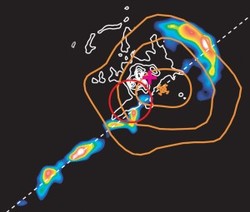A rare jet and arc of molecular gas signal an unusual supernova

Fig. 1: The oddly shaped projectile of gas -- a 'jet' (lower left) and an 'arc' (upper right) -- detected near the Westerlund 2 star cluster.
c 2009 PASJ
A supernova -- the collapse and subsequent explosion of a star -- typically produces an enormous ball of hot and brilliant gas. But the discovery of two vast, irregularly shaped projectiles of molecular gas near the Westerlund 2 (Wd2) star cluster suggests that supernovae can be far from symmetrical.
Yasuo Fukui and colleagues from Nagoya University's Global Center of Excellence for Fundamental Principles in the Universe, in collaboration with scientific teams in Japan, the US, Europe and Australia, have identified a peculiar 'jet' and 'arc' of gas (Fig. 1) using the NANTEN2 submillimeter telescope in Chile.
Although estimated to be more than a million years old, Wd2 is considered a relatively young star cluster and contains some of the hottest and brightest stars that have ever been observed, making it an attractive location for studying stellar events.
To look for molecular gases in Wd2 that could have been impacted dynamically by an earlier supernova, Fukui and his team tuned the NANTEN2 telescope to measure radio waves that are emitted by carbon monoxide molecules under shock-compression in an exploding star.
They found a remnant stream of molecular gas (the jet) 300 light years long, and a crescent shape (the arc) that sweeps out a radius of 100 light years. Both the arc and jet have masses roughly 10,000 times that of our Sun and contain gasses moving at velocities of up to 10 km/s. This is the first time such an anisotropic supernova shape has been observed, and according Fukui, is expected to be a very rare phenomenon.
A jet-like supernova explosion accompanying a spherical shock wave could account for the mass and energy in the jet and arc. The source of their unusual shape, though, is still an open question. Fukui and his colleagues believe one possibility is that the jet is powered by the gravitational field of a micro-quasar located near Wd2.
The NANTEN2 finding is particularly important because the peculiar jet and arc of gas appear to be located near a mysterious source of high-energy gamma-rays. This suggests that the same event that caused the jet may have produced the gamma-ray sources.
"The conventional view is that high-energy gamma-ray sources are evolved objects like black holes," says Fukui, "but Wd2 contains both young stars and a high-energy gamma-ray source. This is a unique combination and very intriguing. Molecular gasses are targets for cosmic-ray protons and their distribution in space is crucial to better understanding the origin of gamma rays."
Affiliated Researchers
The Nagoya University affiliated researchers mentioned in this highlight are from the Quest for Fundamental Principles in the Universe GCOE program.
Reference
Fukui, Y., Furukawa, N., Dame, T.M., Dawson, J.R., Yamamoto, H., Rowell, G.P., Aharonian, F., Hofmann, W., De Ona Wilhelmi, E., Minamidani, T. et al. A peculiar jet and arc of molecular gas toward the rich and young stellar cluster Westerlund 2 and a TeV gamma ray source. Publ. Astron. Soc. Jpn 61, L23-L27 (2009). | article